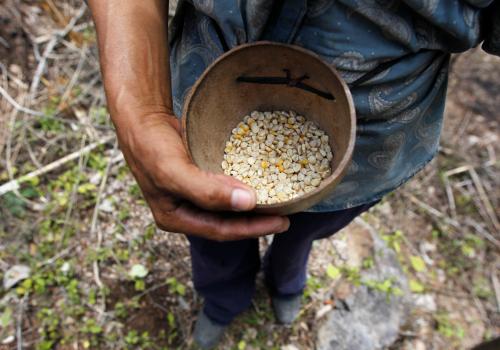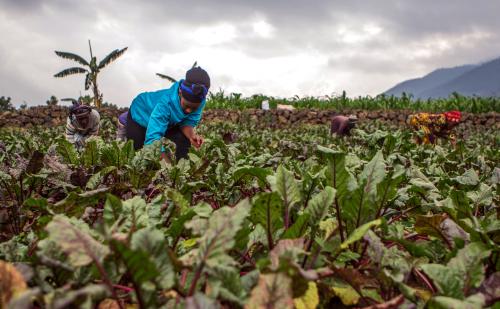Sunday, October 16th was World Food Day, a day to reflect on the fact that almost 800 million people remain chronically hungry in a world where food production is at all-time highs. In honor of the occasion, we have just published an update on progress in ending the rural component of global hunger. We wanted to see if there is evidence yet for a potential break from business-as-usual global trends. Unfortunately, we were not able to find it. If anything the pace of progress might be slowing rather than accelerating.
The most recent Food and Agriculture Organization estimates suggest that, despite a small drop in the percentage of people undernourished, the effects of population growth mean that there were only 3 million fewer hungry people in 2015 than in 2014. Ending hunger by 2030—the target agreed under Sustainable Development Goal (SDG) 2—would require a decline by around 50 million people per year. The same basic pattern holds for malnutrition. The World Health Organization estimates global malnutrition dropped by 0.6 percentage points in 2015; but for malnutrition to be eliminated by 2030 it has to drop by 1.7 percentage points per year.
There have been some hopeful signs—the number of family farmers with access to a bank account has surely gone up given the rapid increase in global financial inclusion that is being reported. Agreements to eliminate agricultural export subsidies are also good steps to removing distortions in global trade in agriculture. But these are unlikely to be game changers in and of themselves.
The persistence of hunger—both undernourishment and malnutrition—depends on where, who, and how food is produced, not just on how much food is produced globally. It depends on access by all families to a healthy and diverse diet. In many countries, especially in sub-Saharan Africa, a large part of the challenge lies in raising yields on family and small-holder farms. As one simple benchmark, the weighted average cereal yield across developing countries in 2014 was about 3.5 tons per hectare (tons/ha), a level that could make a major dent in hunger if achieved everywhere. But 48 developing countries still have cereal yields below 2 tons/ha and, of these, barely half (25 countries) saw higher yields in 2014 while the other half (23 countries) generally saw slightly lower yields.
Developing countries bear the brunt of the responsibility and challenge to improve their own food and nutrition security (FNS). But the most recent assessments by the International Fund for Agricultural Development (IFAD) suggest that policies for rural investment haven’t been improving much. Countries are also not increasing the share of budgetary resources directed toward FNS; of 23 reporting countries for 2014, only 12 saw a real increase in public FNS spending compared to 2013, while 11 had real declines.
Donor countries, too, are not aligning their efforts with the scale of the global FNS challenge. Official development assistance (ODA) for FNS stagnated at $12.5 billion in 2014—the most recent year with data available. And ODA remained volatile; 38 countries received at least 25 percent more ODA in 2014 compared to 2013, but 52 countries saw reductions of at least 25 percent. These swings make it hard for countries to make long-term plans for FNS investments.
Mapping global flows
One of the big challenges to improving international contributions to global FNS is the difficulty in understanding who does what where. To that end, Figure 1 presents a first effort to track cross-border investment flows into FNS-related areas. We estimate that the volume of such flows averaged $28.6 billion per year between 2010 and 2014. Most come from private business and philanthropy, but large volumes are also provided by bilateral governments and multilateral organizations.
Figure 1: FNS flows to developing countries

Source: endingruralhunger.org
Some features of the figure bear emphasizing. U.S. and international nongovernmental organizations are a major channel through which FNS investments are deployed on the ground; they also mobilize resources themselves. They are funded by philanthropies, bilateral governments, and multilateral institutions. They focus on many aspects of rural development, ranging from the supply-side of improving agricultural productivity to the broader challenge of promoting rural development.
The multilateral institutions dedicated to FNS, such as FAO, IFAD, and CGIAR – highlighted as channels for bilateral donors in the figure—play a relatively modest role. Instead, most FNS investments are made by organizations that also make investments in other areas, such as the World Bank and other multilateral agencies. This implies that FNS investments are in constant competition with other sectors within those organizations.
The figure also draws attention to how small the flow of financing is for nutrition, and also for agricultural research. These two major global priorities seem to receive considerably less support than warranted by the scale of the challenges they address. In fact, nutrition funding may even be declining.
What next in 2017?
We believe rigorous benchmarking and practical strategies are crucial first steps to ensuring FNS accountability around the world. SDG 2 will be a headline focus in next year’s High Level Political Forum on sustainable development. Countries can use that occasion to commit to specific national plans for eradicating hunger by 2030.
Similarly, strong practical commitments to accelerate FNS progress could be made at G-7 and G-20 summits. Major economies will have a chance to prove their resolve during replenishments for IFAD and the Global Agriculture and Food Security Program. They can also promote FNS as a priority during negotiations for the replenishment of IDA and the African Development Fund.
Of course investments alone will not solve the problem without ensuring impact. This is why empirical tools are so important for accountability. We have developed one such tool, available at www.endingruralhunger.org. This synthesizes data anchored in a framework of targeting efforts to match each country’s rural hunger needs, policies, and resources. A 2016 update summarizes the most recent data for 153 developing countries; including 37 new countries since last year. The benchmarking approach can also be used for specific countries or regions. For example, an application of the tool to African countries is summarized here. Equally, it can be used to identify how effectively donors are using their instruments in addressing global FNS. A case study of the United States is here.
The upshot of all this is that, to end hunger and achieve the relevant SDG targets, the world needs dramatically more FNS accountability and focus. One year into the SDGs, a breakthrough is still required. In the face of many growing global headwinds, there is ever greater imperative to act.
The Brookings Institution is committed to quality, independence, and impact.
We are supported by a diverse array of funders. In line with our values and policies, each Brookings publication represents the sole views of its author(s).









Commentary
Are we closer to ending rural hunger?
October 17, 2016